
Ocular Challenges? Key Design & Lightning Accommodations in Bathroom Design!
DO YOUR EYES HAVE LIGHT SENSITIVITIES? DO YOU HAVE REDUCED VISION OR ACUTE VISION LOSS OR PHOTOPHOBIA? DO YOU SUFFER FROM EYE PAIN OR CHRONIC DRY, RED EYES?
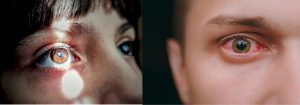
Let’s take a look at key design and lighting accommodations that address these ocular challenges so you can get the most out of your bathroom functionality!
To help us start this journey, SIDLER has been honoured to have Corey Klassen who is the co-founder of the award-winning interior design firm, Articulated Design Studio provide his expertise and insight into this. Please note, Corey Klassen is the co-author of this blog.
When you have ocular sensitives, vision issues/challenges or photophobia, how do you design a bathroom space to accommodate this? What key items should you consider?
It is obvious that you need light to be able to see yourself in the vanity mirror of your bathroom, but there is a myth that pretty and elaborate lighting fixtures illuminate everyone’s face well. As we age, the physical characteristics of our eyes change, and in some cases there are those who have ocular sensitives or challenges due to injury or a medical condition.
So, in lieu of all of this, it can be very challenging to illuminate the grooming centre sufficiently for daily grooming and bathroom tasks such as, make-up application, dental care and face-washing, inserting contact lenses, donning and doffing corrective eyewear, and other detailed tasks at the lavatory sink. Skin tone, physical stature, physical ability, and access needs are additional considerations to address in bathroom design to accommodate the variety of ocular challenges.
With so many considerations, tasks, and activities encompassed in the bathroom ‘work zone’ and grooming centre; this begs the question as to what are the best practices for design and the incorporation of illumination?
Here are the 5 BEST PRACTICES for interior styling and lighting in bathroom design!
GLARE AND VEILING REFLECTIONS
Direct glare, reflective glare, and veiling reflections off materials are all considerations to address. Omni-directional lighting from LED is optimal and often accommodates the least amount of eye strain, but this is not always the rule.
As illustrated in the accompanying images (which features the SIDLER Diamando™ LED mirrored cabinet), for those who apply foundations, eyeshadow, and concealers, etc., reducing glare and shadow are essential. Therefore, a Lumiere that runs the horizontal length of the mirror is ideal. These images are of a lit LED mirrored cabinet showing a horizontal length light to provide such illumination.
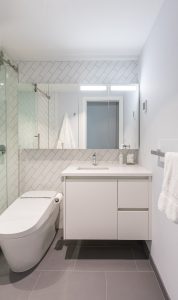
COAL HARBOUR RESIDENCE PROJECT – BY ARTICULATED DESIGN STUDIO (FEATURES THE SIDLER DIAMANDO™ LED)
In some scenarios, layers of different types and locations of lighting (such as a recessed fixture above the edge of the sink) will need to be considered, especially for those who wear corrective eyewear.
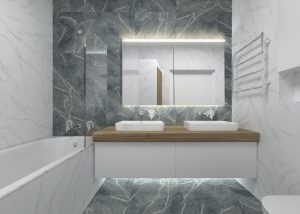
SIDLER XAMO MIRRORED CABINET WITH OVERHEAD VERTICAL LIGHTING
COLOUR RENDITION INDEX VS COLOUR TEMPERATURE
Aside from colour therapy, there are a few guidelines that can be employed when illuminating the bathroom ‘work zone’ in front of the mirror. Most bathrooms will need to achieve a minimum CRI>90 (Colour Rendering Index) for the most clear, crisp and true to life colour and a distortion free mirror reflection above your vanity. The best way to determine if there is enough rendition is if you can faulty see blood vessels on the palm of your hand under the light source.
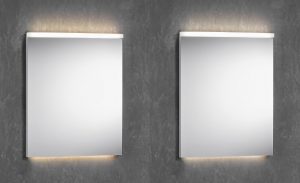
COLOUR TEMPERATURE DIFFRENCE BETWEEN 3000 K (L) VS. 4000 K (R) ON THE SIDLER XAMO COLLECTION
For colour temperature, it’s a good idea to aim between 3000 Kelvin and 4500 Kelvin and avoid the 5000 Kelvin blue-light high-beam (such as the ones found on vehicles) because this can actually cause a loss of focus or a very slow focus in the eye the more we age. And for those with ocular sensitivities or challenges, this is not ideal. Remember, without light we cannot see colour and without adequate lighting we risk injury in a hard-surface space.
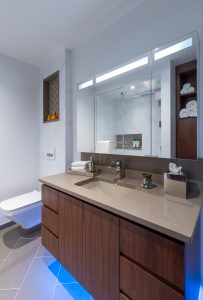
LONDON LANDING RESIDENCE PROJECT – BY ARTICULATED DESIGN STUDIO (FEATURES THE SIDLER DIAMANDO™ LED)
INSTALLATION HEIGHT AND LOCATIONS
There is a common consensus the eye-level to the left and right of the mirror is the best installation location for most users in the bathroom grooming centre. But the flaw in this thinking is, there no two humans are exactly alike and not every space can accommodate. Hence, understanding all the users’ needs in the bathroom ‘work zone’ is essential to be able to select the best lighting fixture and installation location to accommodate the widest variety of needs including ocular sensitivities and challenges.
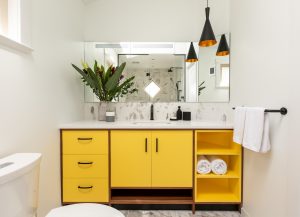
KENSINGTON CEDAR COTTAGE PROJECT – BY ARTICULATED DESIGN STUDIO (FEATURES THE SIDLER DIAMANDO™ LED)
Some other things to consider when installing a mirrored medicine cabinet are items such as moving parts and avoiding a collision with a faucet, light fixture or an installed hand-towel fitting or electrical components on the wall are all errors that can be avoided early on. The height location of the bottom of the cabinet door is approximately 40-inches (1 025 mm) above the finished floor and ideally swings toward a wall.
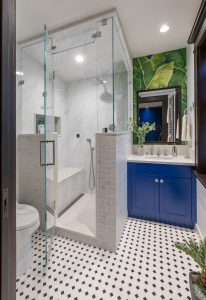
KENSINGTON CEDAR COTTAGE PROJECT – BY ARTICULATED DESIGN STUDIO (FEATURES THE SIDLER DIAMANDO™ LED)
ILLUMINATION CONTROL
A key consideration when applying a control device (e.g., dimmer) for illumination is primarily to address midnight toileting needs. For many of us, the amount of illumination while waking from slumber means the difference between returning to bed for a restful night’s sleep or tossing and turning for a few hours. For those with ocular sensitive or photophobia, these devices can help with reducing brightness to accommodate and reduce any eye or vision irritation.
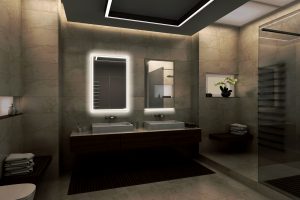
SIDLER QUADRO MIRRORED CABINET WITH DIMMABLE LED LIGHT AND NIGHTLIGHT FUNCTION
Being able to use a low-level of illumination to see just enough to not miss the toilet or get some Advil or Tylenol from medicine cabinet or for grooming tasks while also, being able to use a high-level of illumination means a variety of controls or types of lighting fixtures may need to be utilized in the bathroom design solution.
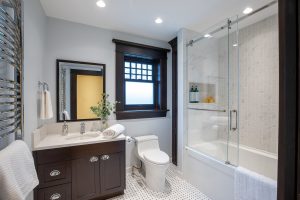
KENSINGTON CEDAR COTTAGE PROJECT – BY ARTICULATED DESIGN STUDIO (FEATURES THE SIDLER DIAMANDO™ LED)
ADDRESSING PRESENT AND FUTURE VISION CHANGES
No one likes to admit that they are aging, yet the fact remains that it’s a one-way street as every single year passes. In order to adequately address any current or future vision changes, it is key to have meaningful conversations early in the analysis phase with the user(s) of the space to be successful.
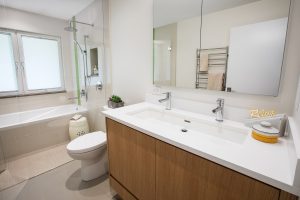
HUNTER PARK RESIDENCE PROJECT – BY ARTICULATED STUDIO (FEATURING THE SIDLER DIAMANDO™ LED)
So, asking questions about the types of activities and tasks they perform in front of the mirror at their bathroom ‘work zone’ is a good starting point.
Examples of some key questions are:
- Is there a need to consider adding a wall-mount magnifying mirror?
- Does it articulate up and down or left and right?
- Does it need to be illuminated?
- Does it have a power supply or need a hard-wire connection?
- Is it accessible from a seated position in front of the work zone?
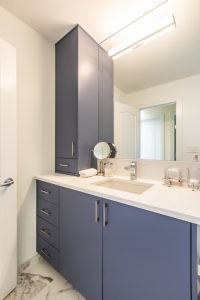
RILEY PARK RESIDENCE PROJECT – BY ARTICULATED STUDIO
These types of considerations, questions, and applied skills are important for the design professional and client to consider when planning task areas in the bathroom. These points are not always going to be absolute because, everyone is different but having some guidelines on how to address illumination in a bathroom for those with ocular sensitivities or challenges is a step in the right direction.
CONCLUSION
Bathroom design is more than just about paint colours or which colour of tile and material to choose or the style of bathroom vanity/cabinetry or the style of toilet, bathtub or shower or storage considerations. Bathroom design also should incorporate practicality in creating a functional space. And this functional space should allow for all everyday bathroom tasks to be performed with ease.
And when it comes to those with ocular sensitivities or challenges; functionality and the ability to perform daily bathroom tasks is especially a must where special considerations and design elements play a key role.
And incorporating the right lighting, the right design elements and practical applications is so key to accommodating those with ocular sensitives, vision issues/challenges or photophobia.
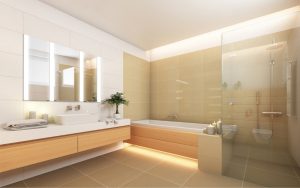
SIDLER MODELLO MIRRORED CABINET WITH DIMMABLE VERTICAL LED LIGHTS
Here are some articles that also provide more great tips on incorporating the correct design elements and lighting in home design for ocular sensitivities
1) Commercial Interior Design article.
